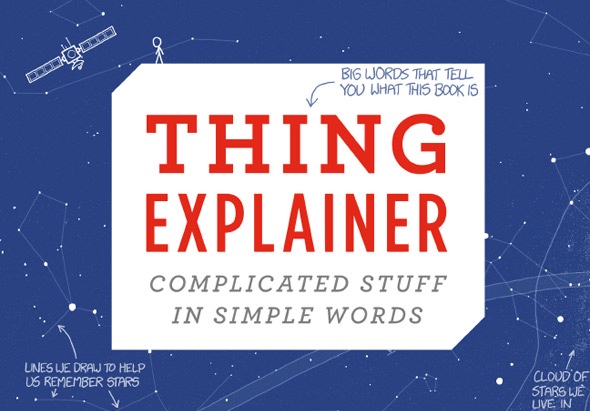It is tempting to take a page from Randall Munroe’s Thing Explainer: Complicated Stuff in Simple Words, and try to write this entire review in, as Munroe puts it, the ten hundred most common words in the English language. It’s an intriguing challenge, because one of the charms of this new book is that it imbues everything between its covers with a childlike and unpretentious sense of delight in humanity’s intellectual achievements.
Still, somehow it makes me want to bust out a thesaurus and get all polysyllabic on you guys.
The creator of the XKCD web comic and author of What If? Seriously Scientific Answers to Absurd Hypothetical Questions, you see, has filled an entire book with diagrams of complicated things: dishwashers, skyscrapers, tectonic plates, even the United States Constitution. He has then proceeded to annotate these using the very simple language left to him by his thousand-word restriction. If this is hard to imagine, check out the Up Goer Five cartoon in XKCD, which is included in the book.
Munroe lays out a rationale for his choice in the Thing Explainer introduction, which says:
“I’ve spent a lot of my life worried that people will think I don’t know enough. Sometimes that worry has made me use big words when I don’t need to.”
This book’s use of language, then is a way of letting go of that fear. Munroe is actively spurning the tactic of using complex language to obscure his meaning, or to create an increased sense of his own cleverness.
Is this just a gimmick, or does it work? It does, and just about perfectly. Thing Explainer is one of those books that most readers won’t tackle on a linear basis. Rather, it’s perfect browsing material. One day you’ll be in the mood for examining its trifold drawing of the night sky, or combing through the periodic table of elements, which has been transformed into a delightful mash-up of bingo card and guessing game. (Imagine quizzing unsuspecting houseguests on items like “Metal That’s Not Very Interesting,” “Air Used in Camera Flashes” and “Green Burning Air That Kills”!) There are diagrams that show the relative size of playing fields for various sports, provided with a handy Venn diagram that lets you see the overlaps between kicking sports, throwing/hitting sports, games that use sticks, and games where you’re allowed to carry a ball. And on the page opposite that? Oh, nothing much–just the geological history of planet Earth.
This is another key bit of the fun in this book: seeing which pieces of the Universe’s puzzlebox and human invention have been set together. Human organs, in an image titled “Bags of Stuff Inside You,” are laid out next to an electric washer and dryer. Where’s the connection? You decide.
The final thing that makes this a stuffed stocking full of treasures, something to be enjoyed at leisure and in any order rather than something you read from cover to cover, is the writing itself. The idea of using simple words is a brilliant one and the text–and there is a lot of text, by the way–offers real illumination on the workings of its various subjects. That said, it is also, by necessity, repetitive, and too much of any good thing can be tiring. Absorbing the content of one or two Thing Explainer pages will leave many readers ready for a linguistic change of pace.
But if Munroe’s contortions with vocabulary make this a shockingly wordy book at times, this one downside is substantially offset by the fantastic line drawings for which he is deservedly beloved on the Internet. His diagrams shed light on the workings of server farms and toilets, nuclear weapons and the food chain. They fill in the random blank spots that we all have about the ubiquitous technology around us. They delight and surprise, teach and occasionally frighten… and there are plenty of laughs to be had, too, both in the phrasing of the explanations of things and in the subject matter conveyed by the combination of words and images.
If anyone would like to try Munroe’s linguistic experiment for themselves using the author’s list of ten hundred common words, they can check their text at xkcd.com/simplewriter. Think of something you understand fully, strip out the terminology, and break the concepts down into the most basic terms you can manage. I’d love to hear how you make out.
A.M. Dellamonica‘s newest book is called A Daughter of No Nation, and you can read the first chapter here! has a book’s worth of fiction up here on Tor.com, including the time travel horror story “The Color of Paradox.” There’s also “The Ugly Woman of Castello di Putti,” the second of a series of stories called The Gales. Both this story and its predecessor, “Among the Silvering Herd,” are prequels to this newest novel and its predecessor, Child of a Hidden Sea. If sailing ships, pirates, magic and international intrigue aren’t your thing, though, her ‘baby werewolf has two mommies’ story, “The Cage,” made the Locus Recommended Reading List for 2010. Or check out her sexy novelette, “Wild Things,” a tie-in to the world of her award winning novel Indigo Springs and its sequel, Blue Magic.










